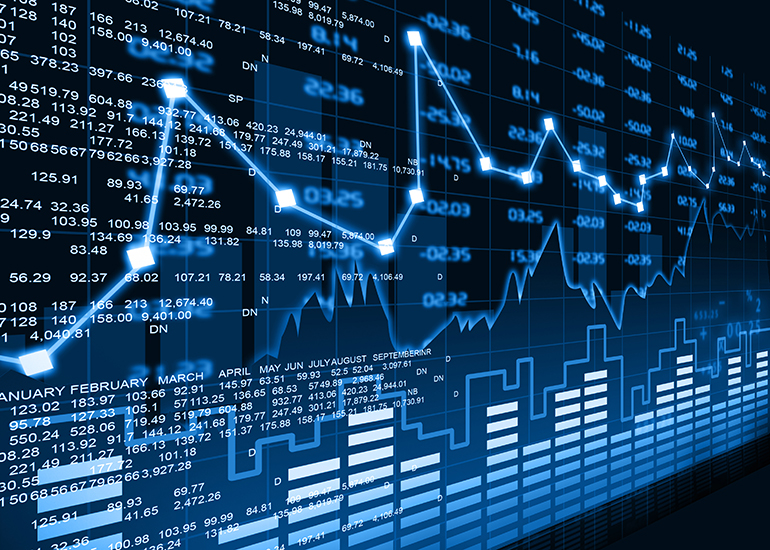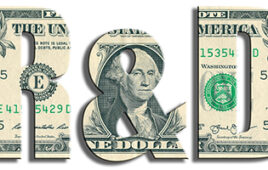
The R&D World Index (RDWI) for the week ending April 2, 2021 closed at 4,577.29 for the 25 companies in the R&D World Index. The Index was up 2.85% (or 126.82 basis points) from the week ending March 26, 2021. The stock of 12 R&D World Index members gained value from 0.14% (Pfizer) to 9.38% (Volkswagen). The stock of 13 R&D World Index members lost value from -0.04% (Eli Lilly & Co.) to -2.31% (IBM).
The U.S. government’s investment in R&D as a percentage of GDP (gross domestic product) has fallen over the past 25 years according to President Joe Biden in his announcement last week of his $2 trillion infrastructure investment plan. As part of this plan, about $180 billion would be committed to R&D and industries of the future, said Biden. While details and a timetable for these R&D investments were vague in the plan, about $50 billion would be earmarked for the National Science Foundation (NSF), $40 billion would be focused on upgrading research labs across the country, $30 billion would be spent on technology jobs creation, especially in rural areas, $25 billion would be spent on projects eliminating racial and gender inequalities and the remaining $35 billion would be spent on clean technologies and climate science. The $40 billion in lab upgrades would include computing networks and advanced semiconductor device technologies. A National Semiconductor Technology Center would also be created. A new office in the Commerce Department would also be created to monitor industrial capacity and fund investments to support critical goods, including semiconductor devices and the materials and systems used in their fabrication.
Biden’s overall plan is termed an infrastructure investment so there also would be massive spending (and R&D) in transportation infrastructure ($600 billion), modernization of public transportation ($85 billion), broadband availability ($100 billion), infrastructure resilience against natural disasters ($50 billion), airport modernization ($25 billion) and other ports and waterways ($17 billion).
These investments would be paid for over the next 15 years with increased taxes on higher income earners and corporations.
RDWI-member Pfizer announced last week that its COVID-19 vaccine (which was authorized for use in 16 and over adults) is now considered 100% effective in protecting against symptomatic disease for children 12 to 15 years of age, following clinical tests of more than 2,200 children. Johnson & Johnson also announced that it is testing its single-dose vaccine in adolescents aged 12 to 17. J&J also plans to test its vaccine in pregnant women. Pfizer is also testing its vaccine in children under 12, while Moderna is testing its two-dose vaccine in children aged six months to 17 years.
China’s Xiaomi, the third largest smartphone maker, announced last week that it is investing about $1.5 billion to enter the electric vehicle (EV) market. Xiaomi is likely to find an outside partner to handle the manufacturing of its EV while it focuses on its design and engineering. China’s software search giant Baidu has also joined with China’s Geely automotive (the manufacturer of Volvo cars) to design and build new EVs. Xiaomi has substantial resources from its smartphone business to fund its EV venture, estimated to cost at least $1 billion annually.
Also in the China arena last week, the Chinese government last week approved the merger between its top two chemical companies — Sinochem Group and China National Chemical. The Chinese state-owned Assets Supervision and Administration Commission will control both enterprises. The resulting combination would create the world’s largest chemicals conglomerate with more than $150 billion in annual revenue and more than $5 billion in combined global R&D investments.
Japan’s Kioxia (formerly known as Toshiba Memory) is being considered as an acquisition target in this era of semiconductor chip shortages. Memory chip makers Micron (with $2 billion in R&D) and Western Digital (with $3 billion in R&D) are both weighing bids to purchase Kioxia at a targeted price of about $30 billion, according to industry analysts. Toshiba (with about $2 billion in annual R&D spending) owns about 40% of Kioxia.
Taiwan Semiconductor Manufacturing Co. (TSMC) clarified its global investment plans last week stating that it will invest a total of about $100 billion to expand semiconductor device manufacturing and fund R&D of advanced technologies over the next three years to keep up with rising demand. New process technologies are becoming more expensive to develop, while new fabs are becoming larger and more expensive to build as noted in this column over the past several weeks with announcements of new fabs by Intel and others. Samsung also has stated that it will invest more than $120 billion by 2030.
Along with other electronics companies, including Amazon, Google and Apple, Microsoft announced last week that it is accelerating its development of its Azure cloud-based technologies at its chip development center in Israel, which now employs more than 2,000 people. The Israeli center includes both hardware and software developers. Bloomberg has recently reported that Microsoft is developing new processors for its Azure servers and laptop computers.
R&D World’s R&D Index is a weekly stock market summary of the top international companies involved in R&D. The top 25 industrial R&D spenders in 2019 were selected based on the latest listings from Schonfeld & Associates’ June 2020 R&D Ratios & Budgets. These 25 companies include pharmaceutical (10 companies), automotive (6 companies) and ICT (9 companies) who invested a cumulative total of nearly 260 billion dollars in R&D in 2019, or approximately 10% of all the R&D spent in the world by government, industries and academia combined, according to R&D World’s 2021 Global R&D Funding Forecast. The stock prices used in the R&D World Index are tabulated from NASDAQ. NYSE and OTC common stock prices for the companies selected at the close of stock trading business on the Friday preceding the online publication of the R&D World Index.



Tell Us What You Think!